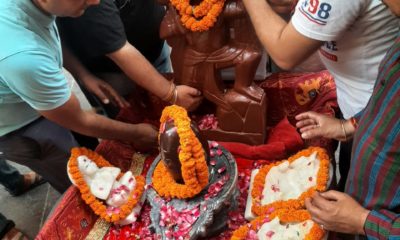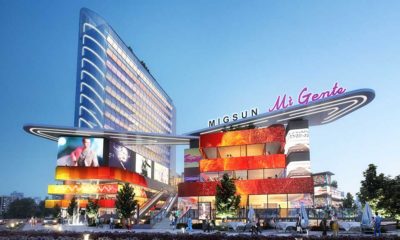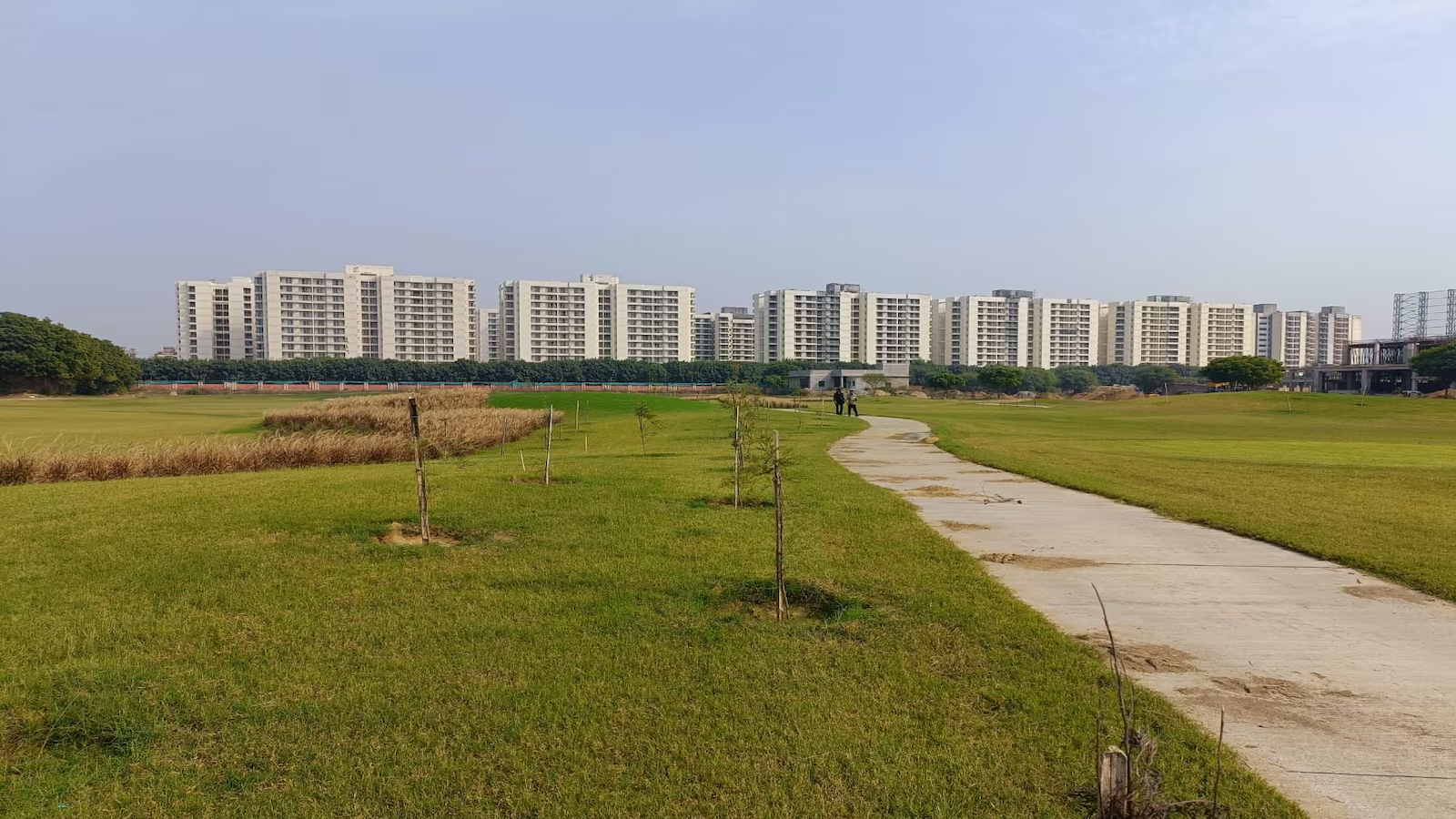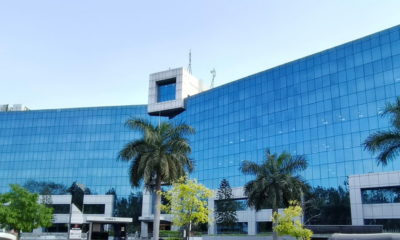News
Going Great in Ghaziabad


Starting with this issue, we will bring out stories on key Government personalities depicting their work and successes. We start with Ghaziabad Development Authority (GDA) Vice-Chairman Santosh Kumar Yadav. Since its creation more than 40 years ago, GDA has come a long way in providing services and developing the infrastructure and development schemes for Ghaziabad. Particularly exemplary has been the focused and hands-on approach of its incumbent chief Santosh Kumar Yadav who can be credited in good measure with this marvellous turnaround for Ghaziabad which has attained an eminent stature in the realty market. As he himself puts it:
” The infrastructure is being planned keeping in mind the population growth for next 50 years “
From a place christened a “sort of a dump” to getting listed among the “10 most dynamic cities” in the world by Newsweek in 2011, Ghaziabad has indeed come a long way. For a place once synonymous with pathetic infrastructure, chaotic traffic and everything else negative to being billed as “India’s hottest city” and getting bracketed with cities like Las Vegas and Munich is no mean achievement. A major credit for this transformation goes to the Ghaziabad Development Authority (GDA), set up in 1973, which has been a harbinger of change for the city located 20 km outside New Delhi, in western Uttar Pradesh. The pace of change has been particularly fast since Santosh Kumar Yadav, 43, took over as Vice-Chairman of GDA in March 2012. A slew of steps taken by him over the past two years have transformed Ghaziabad beyond recognition and made it what it is today—a hot property destination.
A graduate in civil engineering from IIT Roorkee and PG (M Tech) in water resources from IIT Delhi, Yadav had first cleared the Railway Engineering Services examination before qualifying for the IAS in 1995 with an all-India third ranking. Before coming at the helm of GDA, he had held the post of district magistrate in many places in UP, including Ghaziabad, Noida, Aligarh, Bareilly, Muzaffar nagar and Lalitpur. Besides, he has held various other responsibilities including that of the Food Commissioner.
Pursuing his current assignment with a missionary zeal, Yadav reaches office sharp at 9 am and is always there till 6.30 pm and after that a camp office at his residence between 7.30 pm to 9 pm. Despite being a workaholic, Yadav follows a strict regimen, is sufficiently health-conscious and is able to devote quality time to his family as well.
Being an early riser — 4.30 am in the morning —he makes it a point to devote at least an hour to yoga and meditation. Yadav is also a keen golfer and plays badminton and golf on alternate days, at least for an hour. Such healthy lifestyle is, perhaps, the secret behind Yadav’s perpetually young appearance and the storehouse of energy he requires to carry the onerous responsibility entrusted upon him.
In a candid chat with Realty & More, Yadav said: “Ghaziabad has witnessed maximum population growth in the last decade primarily because of settlers from outside.” One of the main reasons for this, he said, was because of Ghaziabad’s proximity and connectivity to Delhi with its eight entry points to the national Capital. “Ghaziabad has the least cost of living in the NCR. Also the quality of water is very good here,” he added. Under Yadav’s leadership, GDA’s slew of steps targeted towards improving the infrastructure, connectivity, housing and overall perception of the city, has led to all-round growth and a new-found popularity for Ghaziabad.
Some strategic and natural advantages were inherited by Ghaziabad right since its birth. Located along side National Highways 24, 58 and 91, it is one of the best connected cities in the country. Two crucial railway tracks lie in its close proximity. The skyrocketing land prices and a virtual saturation of housing in Delhi are the other key factors that have made Ghaziabada preferred destination for businesses and migrants.
GDA has been prudent enough to capitalise on these natural advantages and it went about in an elaborate and planned manner the launching and operation of a flurry of activity across all fronts to ensure a rapid yet balanced development of Ghaziabad.
Ever since its formation as a district in on November 14, 1976, Ghaziabad has moved forward leaps and bounds on the social, economic, agriculture and individual fronts. Ghaziabad, headquarter of the district of the same name, lies on the GT Road about a mile east of the Hindon River.
Ghaziabad is a growing industrial city, its population having increased mainly on account of its rapid industrialization and its proximity to Delhi. A large number of persons reside here but carry on their trades in Delhi or are employed there.
Keeping the historic perspective in mind, one can say with certainty that the development of Ghaziabad and bringing it to its pre-eminent status today has been an arduous task and kudos to GDA, particularly its current boss, for having accomplished that with utmost smoothness and precision.
Housing activity which kicked off a few years back has seen a consistent rise ever since, particularly in areas like Indirapuram and Raj Nagar Extension. The Ghaziabad skyline is now dotted with high rises, business activity has been picking up and malls and shopping arcades are mushrooming. Besides giving a further push to housing, what was required was improving the infrastructure, protecting the environment, widening roads, making them hassle-free and revamping the transportation system. Yadav focused precisely on these as is evident from the raft of measures undertaken by the authority in recent months.
The GDA became the first development authority in the state to launch online facility for its housing schemes in the city. Applicants can now log on to the GDA website www.gdaGhaziabad.com while applying for the authority’s schemes. To reduce hassles of the manual payment process, the authority has roped in an agency where applicants can deposit payments at any bank across the country. They can make payments through internet banking, debit or credit cards. The system will alert applicants about their allotment status and will also send reminders for the schedule of payments payable to GDA. Said Yadav: “We are going to implement the online map approval by the beginning of next year. This will be applicable for both group housing as well as individuals. Once this is implemented I can guarantee approvals in two to five minutes. Everything will be online from submitting to fee deposits.”
Yadav informed Realty & More that all GDA property details are available online. “Everything is mapped on our website where all details including the installments paid and due are present. Such details are also available for developers’ housing societies including whatever map has been approved,” he said. Also the GDA has an online grievance redressal system for which it has an advanced level dedicated call centre where it redresses 250 to 300 complaints on a daily basis. “Everything is recorded, including the complaint and the reply,” Yadav said.
Buildings and Laws
In the middle of September, the GDA board amended the building bylaws that are bound to trigger another round of housing development in Ghaziabad. Yadav said: “We changed the age-old
•A graduate in civil engineering from IIT Roorkee and PG (M Tech) in water resources from IIT Delhi, Yadav had first cleared the Railway Engineering Services examination before qualifying for the IAS in 1995 with an all-India third ranking Under Yadav’s leadership, GDA’s slew of steps targeted towards improving the infrastructure, connectivity, housing and overall perception of the city, has led to all-round growth and a new-found popularity for Ghaziabad.
•Some strategic and natural advantages were inherited by Ghaziabad right since its birth. Located along side National Highways 24, 58 and 91, it is one of the best connected cities in the country building bylaws. For this we studied different bylaws all over the country and picked the best of all. We also took suggestions from developers and incorporated them in the new bylaws.”
“This will ensure availability of more housing units and also create a downwards pressure on the property prices,” he said signalling that more vertical growth is possible in the city now.
One of the major highlights of the amended bylaws is the increase in height of the housing development over plotted development areas. The new changes have cleared construction of buildings, ranging from 112 square metres to less than 2,000 square metres, up to a height of 15 metres along with a stilt floor. The height of the complex will be computed from the plinth level. The new changes also include the construction of four storeys, apart from the stilt floor. As per the existing 2008 bylaws, three stories were allowed for buildings up to 12 metres.
For development of such buildings, the plot should be located over a road of minimum 9 metres in width. Apart from this, a maximum of 12 units are now permitted to be developed.
Keeping in mind the growing need for parking spaces and their provision as per amended bylaws, an equivalent car space (ECS) will be provided. Each individual housing unit will have one ECS for a housing-unit area of 100 square metres.
A housing-unit with area from 101 square metres to 200 square metres will be provided with two ECS. An additional ECS will be given for every 100 square metres for units above the area of 200 square metres. As per the desired conditions rolled out for the new bylaws, it has been stated that permission for development on fully developed/constructed projects would be granted only when all the owners of the plots, in same row/line, provide consent for construction. It is also directed that if such buildings have more than four storeys, they would fall under the provisions of UP Apartment Act, 2010 and rules and by laws framed there in.
The new bylaws also include some incentives to encourage eco-friendly buildings in Ghaziabad. Buildings that get good scores from environment-rating agencies will get an additional 5 per cent floor-to-area ratio (FAR) on the permissible FAR on buildings. However, only eco-friendly buildings, which are more than 5,000 square metres and have certificates from rating agencies, can get the additional FAR permission. In case developers fail to obtain certificates, they will have to pay twice the rate for the area developed under additional FAR.
Road Links
Among the host of steps taken by GDA to make travel in the city smooth and hassle-free is the new 22-km Northern Peripheral Road that will improve connectivity between NH24, NH58 and the state highway, and between peripheral regions of Delhi and Ghaziabad. Another major step in this direction is an expressway from Meerut to Delhi, via Ghaziabad.
The GDA has planned to construct a six-lane bridge across the Hindon river connecting NH24 and NH58 up to Pratap Vihar. The 3.8-km project scheduled to be completed by January next year, will also include a rail overbridge and is projected to cost 2156 crore. The GDA is also building a 9.3-km elevated road over the Hindon canal which will serve as a new link to Raj Nagar Extension (RNE) thereby giving a big boost to private housing in the area. The construction tender of the six-lane road was awarded to a Hyderabad-based private firm recently. A total of 10.3-km road will connect UP Gate to Raj Nagar Extension, with a 9.3km elevated section over the canal supported by pillars. The authority has obtained prior permissions for the project from the UP Irrigation Department. The project is likely to be completed within two and a half years.
Besides planning and building new roads, NH58 has been widened to six lanes. To rid city-dwellers of traffic jams, the GDA made the New Bus Adda tri-junction (Meerut tri-junction) red-light free. Trials have already started for the same. Now for going from Delhi to the main city or Meerut, people won’t have to wait for the green signal. At the same time, traffic moving from the main city to Delhi or Sahibabad will be running smoothly. During peak hours, this point used to be a major traffic bottleneck. The GDA has roped in the Institute of Urban Transport to plan and design all the busy junctions within the city. The authority will now try to make the required land available as early as possible so as to smoothen out the traffic flow in the city.
• The GDA became the first development authority in the state to launch online facility for its housing schemes in the city.
• “We changed the age-old building bylaws. For this we studied different bylaws all over the country and picked the best of all. We also took suggestions from developers and incorporated them in the new bylaws”.
• The new changes have cleared construction of buildings, ranging from 112 square metres to less than 2,000 square metres, up to a height of 15 metres along with a stilt floor


MANU GARG Director, Landcraft Developers


ASHOK GUPTA CMD, Ajnara India Ltd.


RUPESH GUPTA Director, JM Housing


KAMAL BATRA Chairman, Buniyad Group


JK JAIN CMD, Dasnac
Metro Plan
But the biggest boon for the residents of Ghaziabad in terms of improved transportation is the proposed extension of the Delhi Metro from Dilshad Garden to Main Bus Adda in the city. An MoU to this effect was signed in the middle of June this year between the GDA and the Delhi Metro Rail Corporation. An elevated 9.41-km route having seven stations is bound to ease the traffic congestion on roads drastically and provide a booster dose to realty scenario in the area. Yadav also has plans to extend the Metro, particularly to the interiors of Ghaziabad. “We have also planned many extensions for the Metro Rail within the city. DMRC is undertaking a study for the same,” he said.
Green Move
To enhance the green cover in the city, the GDA has undertaken several innovative projects. And a Diwali gift which it has planned for the residents of Ghaziabad is the development of a 100-acre green area in Kerhera village called City Forest. It has sought the help of the School of Architecture and Planning in Delhi to help design the project. Modelled on the Jim Corbett National Park, the City Forest is scheduled for completion by July 2016. Once completed, it is bound to help reduce pollution levels, conserve wildlife, and provide camping facilities for enthusiasts. Some 50,000 trees of different varieties and medicinal gardens planted for the City Forest. The GDA, which will spend Rs15 crore for the development, will try to give it a mountain-like look with the help of trees. It will have a five to six-acre lake, with a grassy landscape of 25-30 acres, a deer park and a bamboo garden. To make the forest completely
• The GDA has planned to construct a six-lane bridge across the Hindon river connecting NH24 and NH58 up to Pratap Vihar. The 3.8-km project scheduled to be completed by January next year, will also include a rail overbridge and is projected to cost Rs156 crore.
• The GDA is also building a 9.3-km elevated road over the Hindon canal which will serve as a new link to Raj Nagar Extension (RNE) thereby giving a big boost to private housing in the area.
• But the biggest boon for the residents of Ghaziabad in terms of improved transportation is the proposed extension of the Delhi Metro from Dilshad Garden to Main Bus Adda in the city
• Many extensions for the Metro Rail within the city is planned. DMRC is undertaking a study for the same.
• A Diwali gift which it has planned for the residents of Ghaziabad is the development of a 100-acre green area in Kerhera village called City Forest
The authority has plans to turn the Hassanpur Lake, a natural lake close to both Ghaziabad city and Delhi, into a national-level tourist destination eco-friendly, the GDA will avoid brickwork and the roads will be built with red sand. Yadav recently conducted a field study of the project along with a team of high-level GDA officials. The authority has plans to turn the Hassanpur Lake, a natural lake close to both Ghaziabad city and Delhi, into a national-level tourist destination. The lake is spread over an area of 250-300 acre and is home to migratory birds. The lake will get a large landscaped parking area, with shades made of solar panels, which will be used to power the electric vehicles that shuttle visitors from the parking area to the lake, and provide solar lighting. Dense ornamental plantation, rest huts and picnic spaces will be provided in the area. It will also include light boats, floating table restaurants, and solar powered boats. Besides this, the GDA also is set to beautify the Arthla J heel at the Indira Priyadarshani Park.
Other Accomplishments
“To improve law and order situation, we have equipped the police force with necessary infrastructure like vehicles and modern equipment”, Yadav informed us. For Raj Nagar Extension, which has witnessed increased housing activity, he said, “We have given land for 220 IN dedicated power sub-station. Also a cricket stadium is planned for which we are in talks with the BCCI, and they have also given us RS6 crore for the same. The stadium will be bigger than the one in Delhi,” a proud GDA chief told Realty & More reeling out the list of the authority’s major achievements. Not without reason, besides being an envy of many a household and office space aspirant, Ghaziabadhas the potential of retaining its prime NCR slot for years to come as “the infrastructure is being planned keeping in mind the population growth for next 50 years,” a contented Yadav shared with Realty & More
in category B neighbourhoods like Andrews Ganj, Kalkaji, Munirka Vihar and Nehru Enclave have been fixed at Z2,04,600 per square metre as against the current rate of Z1,36,400 per square metre.
The circle rates were last hiked in October last year by up to 250 per cent. Officials said increase in circle rates will definitely push up property prices in the city.
Delhi Revenue Secretary Dharam pal said the Government decided to hike the circle rates to cut the black money component in property transactions. He said the Government expects to generate an additional revenue of Rs200 crore from hike in circle rates
LOTUS GREENS LAUNCHES BOUQUEI OF FOUR PROJECTS
Lotus Greens Developers on September 22announced the launch of four premium projects in NCR: Lotus Arena, Lotus Isle, Lotus Parkscape and Woodview Residences. With the launch of four projects at one go, Lotus Greens aims to establish strong footprints in the Delhi-NCR market.
The projects are set to address the varying needs of target consumers from different sections of society. The first project, Lotus Arena, is a premium residential development within the 180-acre Lotus Greens Sports City at Sector 79, Noida. The Lotus Isle is a mixed-use development combining retail, commercial, hospitality and residential spaces within its fold. This project is developed on six acre of land in Sector 98, Noida.
The third project, Woodview Residences, being developed in collaboration with Orris Infrastructure in Sector 89-90 Gurgaon, is a luxury gated community project consisting of low-rise terrace homes. The fourth, Lotus Parkscape, is a group housing development on Yamuna Expressway.
Speaking at the launch, P Sahel, Vice-Chairman, Lotus Greens, said: “Understanding the market dynamics, we foresee great opportunity in NCR region. As a Group, we are working towards developing sustainable communities that will stand the test of time”
GAURSONS HOLDS PROPERTY CARNIVAL
Gaursons India Limited organised a four-day property carnival at Gaur City, Greater Noida West, from October 2 to October 5. The carnival provided an opportunity to homebuyers to see ready-to-move-in properties and facilities available at the Gaur City.
According to a press release, Gaur City, which is the first township who got completion certificate, is ready with world-class facilities like international level day/night cricket stadium, football, basketball and tennis court. The work on Gaur International School has already started and the first session will commence from April 2015.
The carnival also comprised entertainment programmes with lots of food and fun, rock bands and DJ masti with singer Bhupi and Sanam Singh. Manoj Gaur, MD, Gaursons India Ltd, thanked the customers who, he said, had shown faith in the company “during those testing times”


SARE Homes, a FDI-funded real estate developer with seven integrated township projects in the country, organised the ‘Enn Villa, Enn Jilla’ home carnival at its Meadowville township on Grand Southern Trunk Road, in Chennai on September 14.
According to a company press release, the real estate home carnival was a resounding success with over 1,500 visitors attending the event. SARE’s MeadowVille Township drew an encouraging response for the spot bookings. It was also a fun —filled day for the families with special games for children.
Set amid 62 acre, the township is strategically located approx. 3 km off the GST Road at Kolathur, just a 40- minute drive from Chennai central.
Commenting on the occasion, Vineet Relia, Managing Director of SARE Homes, said, “SARE Homes is focused on delivering world-class homes at good value to the home buyers in Chennai and neighbouring areas”
-



 News3 weeks ago
News3 weeks agoKW Delhi 6 Mall Onboards New Brands
-



 News4 weeks ago
News4 weeks agoManasum Senior Living Launches IKIGAI GOA, A Senior Living Community in North Goa, in collaboration with Prescon Homes
-



 News2 weeks ago
News2 weeks agoGodrej Properties Sells Rs 3k cr+ Homes of Godrej Zenith, Gurugram, within 3 days
-



 News4 weeks ago
News4 weeks agoBridging India Divide: Top 5 Tier- 2 Cities to Focus On
-



 News3 weeks ago
News3 weeks agoCommercial Realty Gets Tech Savvy: Fast Construction, Enhanced Convenience
-



 News4 weeks ago
News4 weeks agoMultipoint Connection – A Definite Boon
-



 News3 weeks ago
News3 weeks agoRBI’s Status Quo on Key Policy Rates to Help Maintain the Real Estate Growth Momentum, Say Industry Stalwarts
-



 News1 week ago
News1 week agoOlive Announces Dhruv Kalro as Co-Founder
































